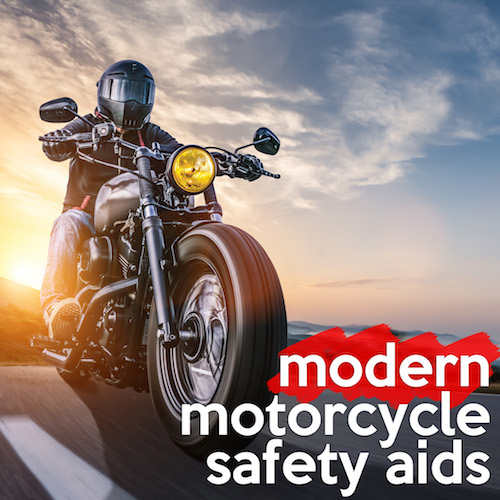Visualize the size of the average credit card or business card—this is the approximate size of the contact patch between a motorcycle’s tires and the road. Then remember: Unlike cars, motorcycles inherently lack the benefit of enclosing their operators in a protective metal cage. Why is this significant?
These facts support the unfortunate yet incontrovertible truth that motorcycles are more dangerous than cars. Riders can do their part to maximize their own safety; we’ve written articles about basic motorcycle safety, safe traveling practices, and basic motorcycle maintenance.
Practicing ATGATT (wearing all the gear, all the time), staying cognizant of other vehicles on the road, and keeping up with maintenance will undoubtedly make any motorcycle rider safer. However, there is a final piece of the puzzle that is just as important as the rest: electronic safety aids, the last line of defense that consists of several key systems.
ANTI-LOCK BRAKE SYSTEM (ABS)
Firstly is an anti-lock braking system, otherwise known as ABS. In a car or motorcycle without ABS, employing strong, sudden braking—such as when encountering an unforeseen pothole or wild animal darting across the road—may result in the wheels locking up and the vehicle skidding out of control.
It does not exactly take a rocket surgeon to deduce that such a scenario can prove quite dangerous, especially on a motorcycle. While a car with locked up wheels may at best momentarily lose traction and at worst fishtail out of control, the same situation on a motorcycle may result in a lowside or highside crash, respectively.
ABS addresses this issue by preventing the wheels from locking up under hard braking. Since the wheels can’t lock up, they can’t lose traction with the road, alleviating much of the risk (e.g., a crash) of such a scenario. Most modern motorcycles have ABS available but this rule is not set in stone.
TRACTION CONTROL SYSTEM (TCS)
Even in the worst case scenario of a sudden loss of traction, modern safety aids may yet save a rider. As the name suggests, traction control is an electronic system which detects any temporary loss in traction and corrects it, usually by cutting engine power. Since a motorcycle only drives its rear wheel, this stops the rear wheel from receiving power and spinning.
Traction control systems (or TCS) help correct unintended slides, wheelies, and burnouts. TCS is particularly important when traveling over slippery surfaces, allowing a rider to safely cruise and retain traction while maintaining speed. Just as with ABS, the unfortunate reality is that not all modern motorcycles have traction control.
At the end of the day, traction control may be the difference between a serious crash and a great story to tell about avoiding one. While using tires in good condition (remember to keep up with maintenance!) and exercising proper throttle control may suffice for some riders, TCS is a valuable electronic safeguard to have, even for a veteran rider.
STABILITY CONTROL
Some manufacturers not only offer traction control, but stability control systems as well. These are sometimes referred to as motorcycle stability control (MSC) systems and encompass traction control under a broader electronic safety aid suite. Regardless of their designation, all stability control systems perform very similar functions.
While TCS merely prevents the rear wheel from slipping due to a loss in traction, stability control combines this functionality with ABS while also calculating lean angle. The result is a holistic electronic safety aid system which not only assists a rider in safely braking, but safely accelerating as well.
Stability control systems are currently at the leading edge of electronic motorcycle safety technology. Not all modern bikes will have stability control, let alone TCS. Riders who are fortunate enough to own stability control-equipped bikes will reap qualitative benefits in safety over those without a similar technology suite.
SAFETY FIRST!
Motorcycles will naturally never offer the same level of safety that cars and other fully-enclosed road vehicles do. However, that doesn’t mean that riders are completely unprotected—or will let that fact deter them anyway. Practicing ATGATT, staying aware of potential road hazards, and taking care of basic maintenance are just some of the key components behind staying safe.
Electronic safety technology comprises the last piece of the puzzle. Systems like ABS, TCS, and stability control act as the last line of defense regardless if one is riding in hazardous conditions or just cruising around town. These electronic safety aids save lives, prevent serious injury, and are an important component of ensuring the utmost safety of riders on the road.
What is your opinion on electronic safety aids: unnecessary and obtrusive or an all-important component of proper modern riding safety? Sound off in the comments below!
